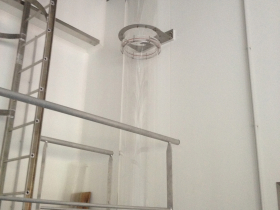Influence of the physiological condition of bivalve recruits on their post-settlement dispersal potential
Influence of the physiological condition of bivalve recruits on their post-settlement dispersal potential
Forêt M., Olivier F., Miner P., Nadalini J.-B., Winkler G. et Tremblay R., 2020. – “Influence of the physiological condition of bivalve recruits on their post-settlement dispersal potential”. Marine Ecology Progress Series, 636:77-89. DOI: 10.3354/meps13223.
Secondary dispersal (= migration) of bivalves occurs after metamorphosis and is a key recruitment process that can radically change patterns of primary settlement. An example of secondary dispersal is active migration behavior of bivalve recruits such as in bysso-pelagic drift. We hypothesize that these active migrations represent an energy cost for recruits and that the ability to actively migrate will depend upon the recruit’s physiological profile (quantity and quality of energy reserves). In lab experiments, we hatched 4 batches of recruits of Venus verrucosa with different physiological profiles by varying rearing temperature and diet composition. We then introduced these recruits into a fall velocity tube (5 m height) to estimate their vertical fall velocity as a proxy of their dispersal potential: slower fall velocity implies enhanced dispersal potential. We also compared alive vs. passive (dead) recruits to assess behavioral differences. Fall velocity increased logarithmically with recruit volume for each treatment, and no differences between active and passive individuals were observed for batches reared at 20°C with a mixture of Tisochrysis lutea and Chaetoceros gracilis. By contrast, active recruits in 2 other treatments (T. lutea at 20°C and a mix of C. gracilis and T. lutea at 15°C) significantly decreased their fall velocity regardless of their volume. Moreover, the ability of recruits to control their fall velocity by their behavior was correlated with triglyceride content. Recruits with the highest energy reserves had the greatest capacity to decrease their fall velocity, which suggests a major role of physiological conditions on potential secondary dispersal. We also used a benthic flume to test the substrate selection ability of recruits depending on their physiological profile and found no differences between physiologically different batches. However, V. verrucosa recruits preferred fine sediments, unlike adults, which live mainly in coarse sediment habitats; such difference in substrate preference suggests potential secondary migrations between nursery and adult areas.
BOREA contact: Frédéric Olivier



